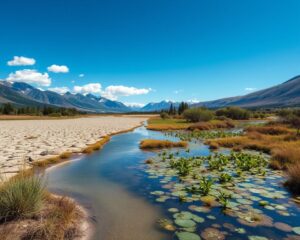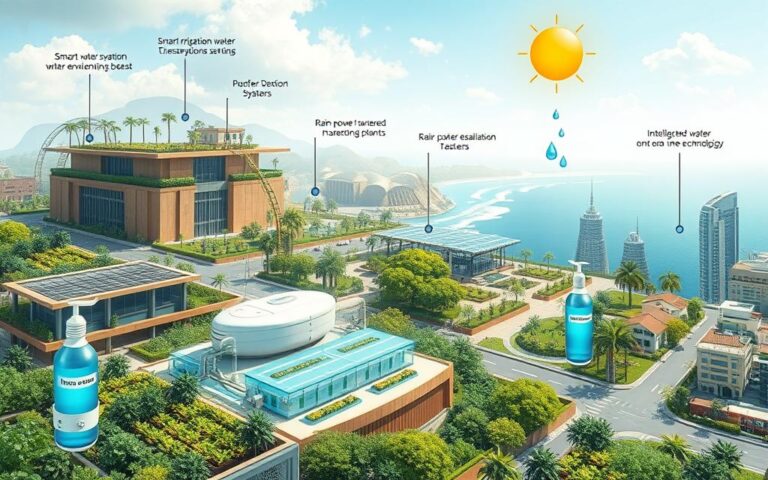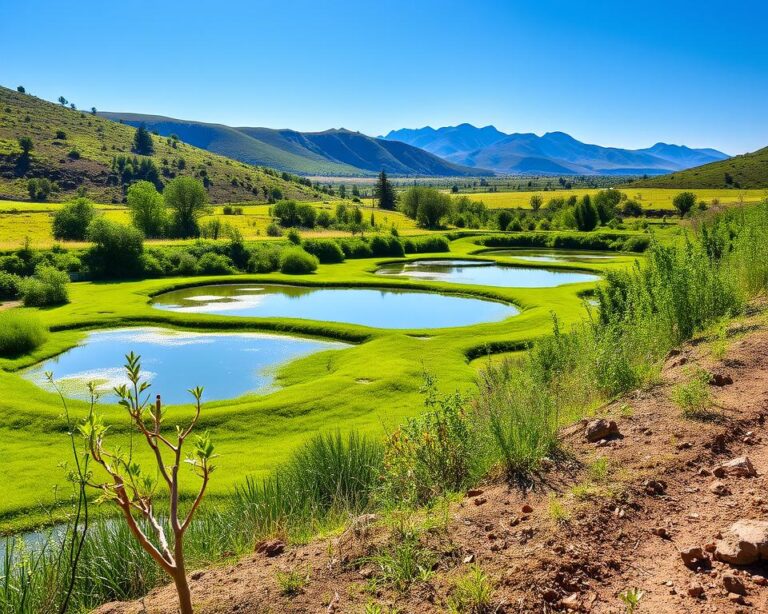Did you know only 0.5% of Earth’s water is usable freshwater? This fact shows how crucial water conservation is, especially with climate change affecting our water. With water scarcity threatening billions, it’s key to learn and use sustainable water management.
Glaciers are melting, and rain patterns are changing. This puts our clean water at risk. By starting water conservation now, you help protect water for the future. It also fights climate change’s effects.
Understanding Water Conservation
Water conservation is key to managing our limited water resources. As more people and climate challenges arise, it’s crucial to use water wisely. By using different techniques, we can greatly reduce our water use.
What Is Water Conservation?
Water conservation means using water efficiently to avoid waste. Only about 3% of the world’s water is fresh and suitable for use. With over 40% of the world’s population facing water shortages, it’s vital to understand conservation.
Simple actions like fixing leaks and using water-saving appliances can make a big difference. For example, an average person uses around 140 liters of water daily. This shows we can all do better by making conscious choices.
Why Is It Essential?
Water conservation is crucial due to the looming water scarcity. Almost 2 billion people lack access to safe drinking water, and this number is expected to grow. Without change, half of the global population may face water shortages by 2025.
Water scarcity harms the environment and causes social conflicts. It can even lead to communities being displaced. Simple actions like taking shorter showers or using rainwater can save a lot of water. In a world where every drop matters, working together and learning about conservation is essential for a sustainable future.
| Water Usage Activities | Average Water Consumption (liters) | Water Conservation Suggestions |
|---|---|---|
| Taking a shower | 6 – 45 | Install low-flow showerheads |
| Taking a bath | 80 | Opt for a quick shower instead |
| Running a tap (while waiting for it to run cold) | 10 | Collect water in a container |
| Dripping tap | 15/day | Fix leaks promptly |
| Sprinkler use | 1,000/hour | Use drip irrigation systems |
The Impact of Climate Change on Water Resources
Climate change and water resources face big challenges. It affects how much water we have and how we get it. Knowing how these two interact is key to managing water well.
You might notice changes in your water supply. This is because weather patterns are changing. These changes can affect how easily you get to this essential resource.
How Climate Change Affects Water Supply
Warmer air can hold more moisture. This means more water evaporates from oceans, lakes, and soil. This leads to drier conditions, impacting our drinking water and farming.
The northeastern U.S. sees more intense storms. But the West and Southeast face longer droughts. These changes highlight the need for better water management.
The Role of Drought in Water Scarcity
Droughts make water shortages worse, especially in areas already struggling. They hurt farming, sanitation, and community life. Climate change will make droughts even more severe in some areas.
Studies show nearly half of U.S. water basins might not meet demand by 2071. We need to manage water better to tackle these drought challenges.
Everyday Water Conservation Tips
Making small changes in your daily routine can make a big difference in saving water at home. Simple practices can save water and lower your utility bills. They also help the environment. Here are some effective ways to save water at home.
Simple Changes You Can Make at Home
Start with these easy adjustments:
- Turn off the tap while brushing your teeth. This simple act can save multiple gallons of water every day.
- Check for leaks in faucets and toilets. Even a minor drip can waste up to 200 gallons of water daily.
- Run the dishwasher and washing machine only when fully loaded to maximize water use.
- Water the lawn only when necessary and opt for deep soaking to promote root growth and prevent wastage.
- Use a broom instead of a hose to clean driveways, saving hundreds of gallons of water.
- Replace high-flow showerheads with water-saving shower heads that reduce flow to about three gallons per minute.
- Install low-flow aerators on tap faucets to significantly cut down on water usage.
Water-Saving Appliances
Adding water-saving appliances to your home is a smart move. It helps reduce water use. Here are some options:
- High-efficiency washing machines can save over 50% in both water and energy use.
- Installing a plastic bottle in the toilet tank can save five gallons or more of water daily.
- Purchase appliances labeled as water-saving to ensure your home benefits from eco-friendly water solutions.
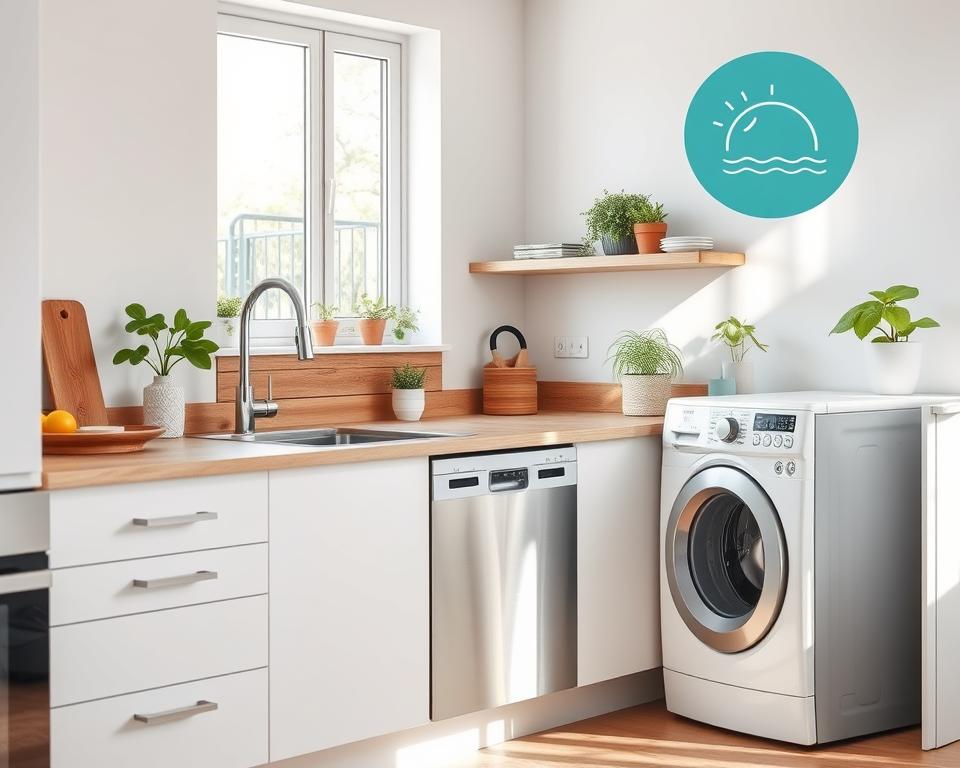
By following these tips, you help a lot with water conservation at home. Every small action helps use water more sustainably. Start today for a greener future.
The Benefits of Conserving Water
Water conservation offers many benefits, not just for the planet. It can also save you money and help the environment. By using less water, you can cut down on your expenses and support sustainable practices.
Financial Savings
Conserving water can save you thousands of dollars each year. Using less water means lower water bills. For instance, water-efficient fixtures can cut your water use by 20% or more.
Fixing leaks is another way to save money. Leaks can waste up to 180 gallons of water each week. By fixing these, you can save even more.
Environmental Advantages
Water conservation is great for the environment too. It reduces the energy needed to treat and deliver water. This cuts down on pollution and saves fuel.
It also helps keep water available for future generations. In areas with droughts, saving water is especially important. By conserving water, you help protect the Earth’s resources.
| Benefits | Details |
|---|---|
| Financial Savings | Saves thousands annually by reducing water bills and utility costs. |
| Leak Prevention | Addressing leaks can conserve nearly 9,400 gallons of water yearly. |
| Environmental Impact | Decreases energy consumption and pollution associated with water processing. |
| Future Water Quality | Ensures a sustainable supply of clean water, vital for residential and agricultural needs. |
Water Footprint: Understanding Your Usage
Knowing your water footprint helps you see how much freshwater is used to make things you use every day. It shows how much water you use and encourages you to use water more wisely.
What Is a Water Footprint?
A water footprint is the total water used directly and indirectly. In the US, the average person uses about 1,802 gallons per day. This includes water used at home and for food and goods.
For example, making a pair of jeans needs 2,080 gallons of water. One steak requires about 880 gallons. These numbers show how what we buy and eat affects our water use.
Calculating Your Personal Water Footprint
To figure out your water footprint, start with your home water use. The average person in the US uses about 60 gallons of water daily. Think about how much water you use for things like showering and laundry.
Then, look at the water used for your food and products. Food production is a big part of your water use. By making small changes, you can use water more sustainably. For example, using less water outside can cut your water use by a lot.
The Role of Agriculture in Water Conservation
Agriculture is key in managing water resources. It’s vital to use sustainable farming to save water. Freshwater used for farming is a big part of the global use. By using less water and being more efficient, farmers help keep water resources safe.
Sustainable Farming Practices
There are new ways to farm that save water and make soil better. Some of these include:
- Drip irrigation: This method cuts down on water lost to evaporation and runoff. It helps crops grow stronger and yields increase.
- Compost and mulch: These improve soil health. They also help keep water in the soil and reduce evaporation.
- Crop rotation: Changing crops helps use water better and makes soil more fertile. It’s good for farming in the long run.
- Conservation tillage: This method reduces soil erosion. It also helps the soil hold water better and manage moisture better.
- Dry farming: Using natural rainwater reduces the need for irrigation. It helps plants absorb more water.
How Consumers Can Support Water-Efficient Products
As a consumer, you can help by choosing water-efficient products. Here’s how:
- Look for products labeled as sustainable.
- Buy from local farmers who use water wisely.
- Support policies that help save water in farming.
- Tell others why sustainable farming is important.
Your support can encourage farmers to use water-saving methods. Together, we can make farming more sustainable and protect our water resources.
| Farming Practice | Benefits | Impact on Water Conservation |
|---|---|---|
| Drip Irrigation | Minimizes evaporation and runoff | Significantly reduces water usage |
| Mulching | Enhances soil health | Reduces water loss |
| Crop Rotation | Boosts soil fertility | Optimizes water use |
| Conservation Tillage | Improves moisture retention | Lessens soil erosion |
| Dry Farming | Maximizes natural rainfall usage | Reduces irrigation dependency |
Local and National Water Conservation Initiatives
Water conservation efforts are crucial at both local and national levels. They help tackle the issue of water scarcity. Community programs empower people to contribute to sustainable water use. These programs include educational campaigns and incentives for using water-efficient technologies.
Community Programs You Can Join
There are many community programs focused on water conservation. Local organizations host workshops and events to teach about efficient water management. These programs encourage residents to participate in activities like:
- Neighborhood clean-up events focusing on local water bodies
- Water-efficient landscaping workshops
- Incentive programs for replacing old fixtures with water-saving appliances
Joining these programs helps in collective efforts to conserve water. It also fosters a sense of community and shared responsibility.
Government Policies on Water Management
Government policies are key in shaping water conservation efforts. Recent investments show a commitment to sustainable practices. For example, the Department of the Interior is investing $140 million in water efficiency projects in the western United States.
This investment will support 84 projects in 15 states, saving over 230,000 acre-feet of water. This is equivalent to saving 77 billion gallons. Such efforts are crucial for ensuring water supplies for over 940,000 people.
In the Colorado River Basin, over $20 million is allocated for federal funding. This is complemented by more than $44.7 million in infrastructure investments. Community programs in this region aim to achieve significant water savings, highlighting the importance of effective water management policies.
Learning about local and national water conservation initiatives helps you advocate for better water management policies. These policies should focus on sustainability and fair access to water resources for all communities.
The Importance of Education and Awareness
Teaching people about water conservation is key. It helps create habits that last forever. By starting with kids, you set the stage for a greener future. Programs that teach water conservation education help build a sustainable community.
Teaching Children About Water Conservation
Teaching kids about water saves them and the planet. Small changes now can make a big difference later. Hands-on learning makes it fun and effective.
Studies show that interactive learning boosts water-saving knowledge by 30%. The Texas Corn Curriculum has made a big impact in schools. About 80% of Texas schools now teach water conservation.
Spreading Awareness in Your Community
Community efforts are crucial for water conservation. Workshops, cleanups, and campaigns get people involved. A project in one community showed how effective education can be.
By asking residents about their water use, they learned a lot. This led to a big water-saving effort. Getting everyone involved helps protect our water sources.
Innovations in Water Conservation Technology
The world faces a growing water shortage, and new technologies are key to solving it. These innovations make water use more efficient and support sustainable living. They focus on smart irrigation and advanced water recycling.
Smart Irrigation Systems
Smart irrigation systems are a big step forward in farming. They use the latest tech to water plants just when they need it, based on weather data. This can cut water use by up to 50%.
Agriculture uses about 70% of the world’s water. AI-powered irrigation systems are even more effective. They cut down on water waste and help farmers save money.
Advanced Water Recycling Techniques
Greywater recycling is a new way to save water. It uses water from sinks, showers, and laundry for plants. This method helps communities use less fresh water.
New tech like solar desalination and forward osmosis also help. They treat water efficiently, saving energy and making water available in dry areas.
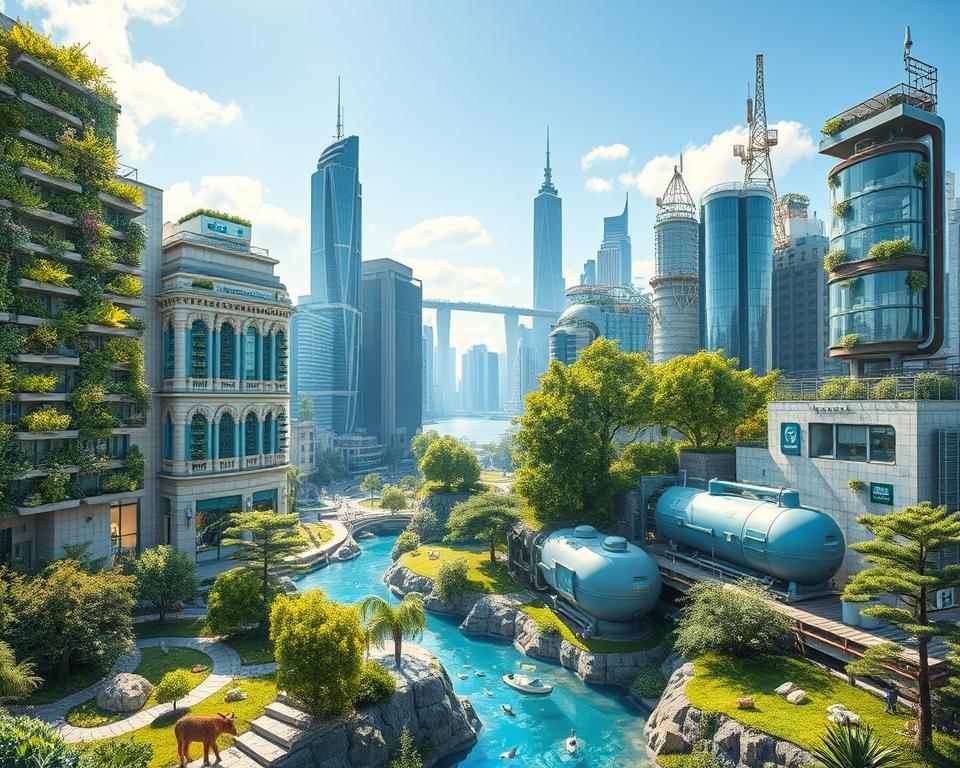
| Water Conservation Technologies | Benefits | Impact on Water Use |
|---|---|---|
| Smart Irrigation Systems | Optimizes watering schedules | Reduces consumption by up to 50% |
| Greywater Recycling | Repurposes wastewater | Decreases freshwater reliance |
| AI-Driven Technologies | Detects leaks, improves efficiency | Minimizes water loss by up to 30% |
| Solar Desalination | Energy-efficient water treatment | Increases availability in arid regions |
Collaborating for Stronger Water Conservation Efforts
Strong water conservation needs teamwork. Working with local water groups lets you meet people who love water. Together, we can make our community more aware and active in saving water.
Joining Local Water Conservation Groups
Joining local groups helps you join big projects. They host workshops, clean-ups, and campaigns. This way, you help keep our water safe.
- Get tips on saving water.
- Meet experts and people who care.
- Help change laws for better water.
Partnering with Businesses for Greater Impact
Businesses can help a lot in saving water. Working with them makes everyone use water better. This helps our community and the planet.
| Aspect | Community Benefits | Business Benefits |
|---|---|---|
| Resource Efficiency | Better water for everyone. | Save money by using water wisely. |
| Public Awareness | More people know about saving water. | Look better to customers by caring for the planet. |
| Community Engagement | People can help save water. | Work with others on big projects. |
Working together, we can do more for water. By joining groups and partnering with businesses, we all help keep our water clean and safe.
The Future of Water: Preserving Our Most Vital Resource
As threats to water grow, we must find lasting ways to keep our water safe. We need to create and follow strict water use rules. Also, we should invest in new, water-saving technologies.
By doing these things, we can start to fix the water shortage that affects over 40% of people worldwide.
Long-Term Solutions for Water Sustainability
Creating a sustainable future is not just about new tech. It’s also about changing how we think about water. We need to teach people and push for saving water.
By doing this, we can create a world where every drop of water matters. Simple steps, like using water-saving appliances or collecting rainwater, can make a big difference.
Encouraging Responsible Water Use in Future Generations
To make sure future generations have a better world, we must teach them about saving water. We should add water conservation lessons to school and community programs.
Getting kids involved in planting water-saving plants can cut down on water use by half. Together, we can make a big change and keep our water safe for the future.

